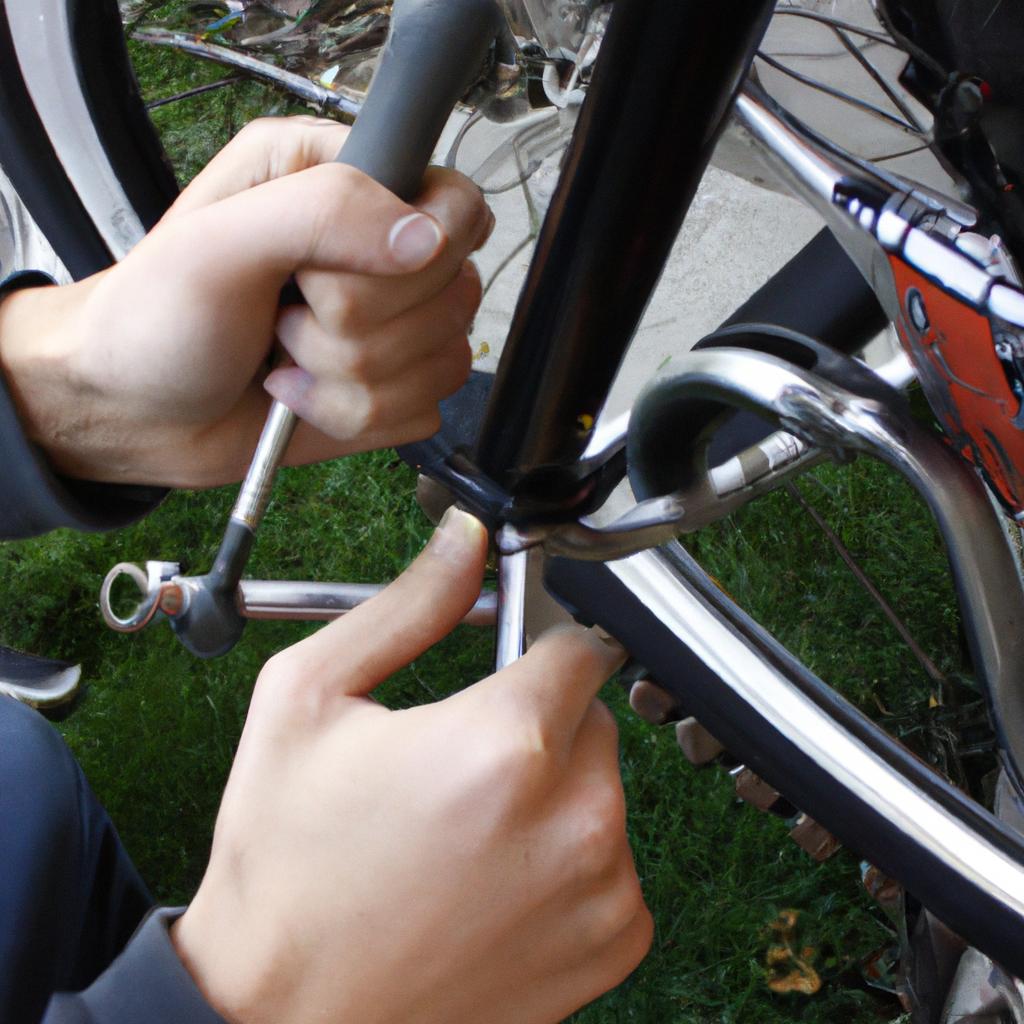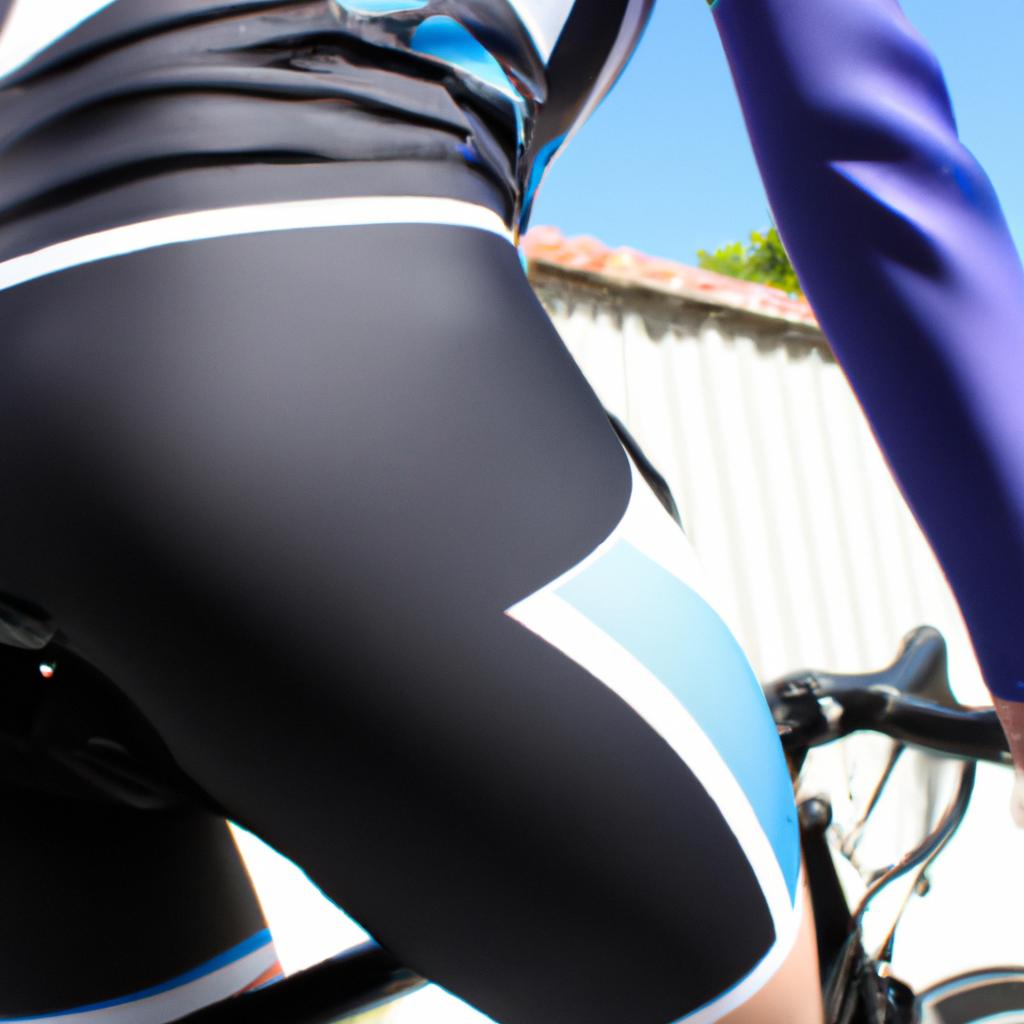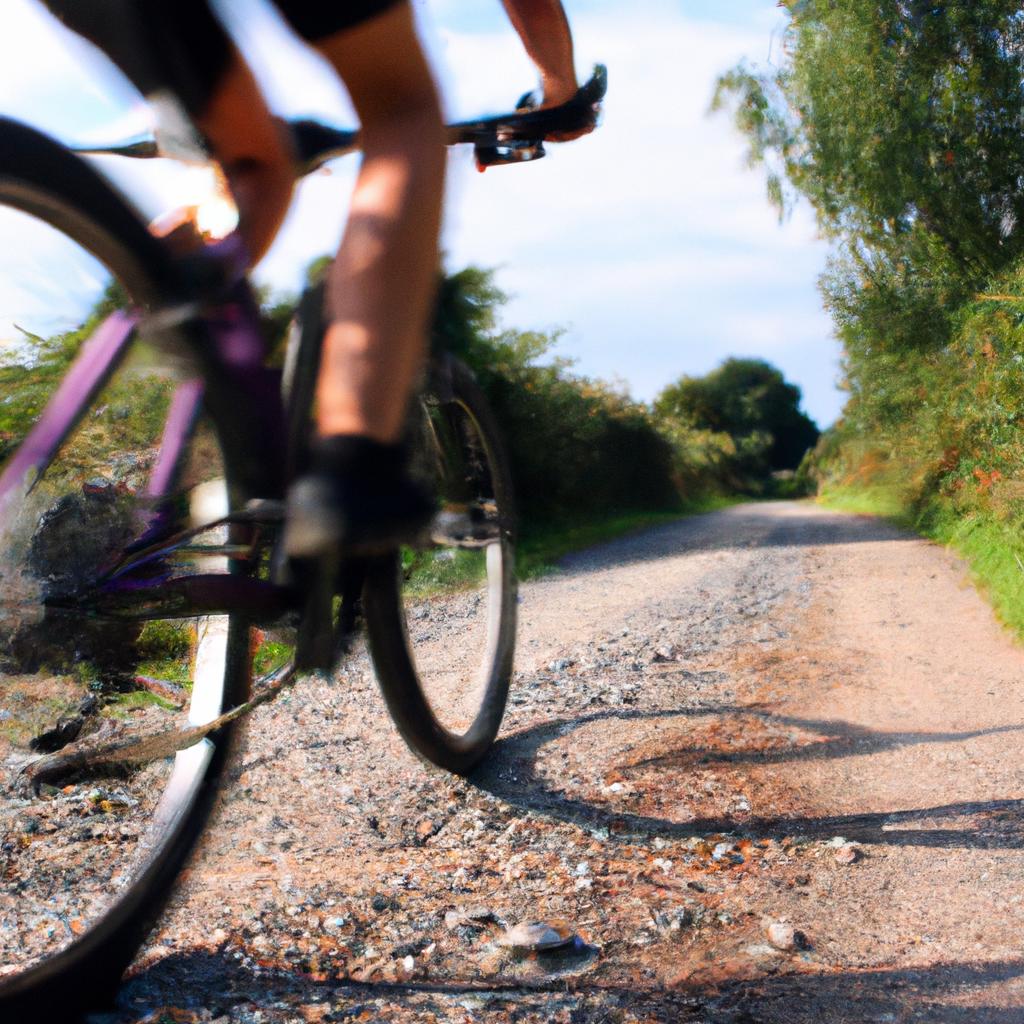Cycling has become an increasingly popular recreational and sports activity, attracting individuals of all ages and fitness levels. However, as the number of cyclists on the roads continues to rise, so does the need for proper cycling etiquette. Understanding and adhering to cycling etiquette not only ensures a safer and more enjoyable experience for all riders but also contributes to harmonious coexistence between cyclists and other road users.
Consider this scenario: John is an avid cyclist who enjoys long rides on weekends. One sunny afternoon, he decides to explore a new route that takes him through bustling city streets. As he navigates his way through traffic, John encounters several fellow cyclists along the way. Some ride in pairs or groups while others zoom by at breakneck speeds. Amidst the chaos, it becomes evident that there is a lack of consistency in how cyclists interact with each other and with motorists alike. This situation highlights the importance of understanding and following proper cycling etiquette to ensure smooth interactions among all parties involved.
In this article, we will delve into various aspects of cycling etiquette, providing a comprehensive guide for both recreational and sports enthusiasts alike. By discussing key principles such as communication, safety measures, right-of-way rules, and respect for others on the road, we aim to equip readers with the knowledge and understanding to navigate the cycling world with courtesy and consideration.
One of the fundamental aspects of cycling etiquette is communication. Cyclists should use hand signals or verbal cues to indicate their intentions, such as turning left or right, slowing down, or stopping. By communicating effectively, cyclists can alert others on the road of their actions, reducing the risk of accidents and promoting a safer environment for everyone.
Safety measures are another essential component of cycling etiquette. It is crucial for cyclists to wear proper safety gear, including helmets and reflective clothing, especially when riding in low light conditions. Additionally, maintaining a safe distance from other riders and vehicles is vital to prevent collisions. Adhering to traffic laws, such as obeying stop signs and traffic signals, also contributes to overall safety on the road.
Understanding right-of-way rules is essential for harmonious interactions between cyclists and other road users. Cyclists should yield to pedestrians in crosswalks and give them ample space when passing by. When sharing the road with motorists, cyclists should ride predictably and follow traffic patterns while being mindful of any designated bike lanes or paths available.
Respect for others on the road forms the foundation of cycling etiquette. This includes showing consideration towards fellow cyclists by not abruptly cutting in front or blocking their path unnecessarily. When overtaking slower riders, it is courteous to provide a warning before passing and leaving enough room for both parties to safely continue their journey.
In conclusion, following proper cycling etiquette is crucial for creating a harmonious coexistence between cyclists and other road users. By communicating effectively, prioritizing safety measures, understanding right-of-way rules, and respecting others on the road, cyclists can contribute to a more enjoyable and secure experience for everyone involved. So whether you are an experienced rider or just starting out on your cycling journey, remember that practicing good etiquette not only benefits yourself but also helps foster a positive relationship between cyclists and the community at large.
Understanding the Right-of-Way
Imagine you are cycling on a scenic trail, enjoying the fresh air and beautiful surroundings. As you approach an intersection, another cyclist appears from your right side. Who has the right-of-way? Understanding and following proper cycling etiquette is essential for ensuring safety and harmony on shared paths. In this section, we will explore the concept of right-of-way and its significance in recreational and sports cycling.
To begin with, it is important to note that right-of-way refers to the privilege given to one user over another when they reach a point where their paths intersect. This principle helps establish order and prevents potential conflicts among cyclists. Typically, the general rule is that cyclists should yield to those who already occupy or enter an intersection before them. However, there can be variations depending on local regulations or specific circumstances.
When determining who has the right-of-way in different situations, consider these key factors:
- Traffic signs and signals: Just like motorists, cyclists must obey traffic signs such as stop signs or traffic lights.
- Priority lanes: Some trails may have designated priority lanes for faster-moving cyclists or certain groups (e.g., pedestrians).
- Pedestrians: Cyclists should always give way to pedestrians at crosswalks or areas where foot traffic is present.
- Visibility: When approaching blind corners or obscured intersections, exercise caution and adjust your speed accordingly.
By adhering to these guidelines, cyclists can minimize potential conflicts and promote a safer environment for everyone involved. Maintaining awareness of your surroundings while cycling allows you to anticipate other users’ actions and react appropriately.
| Situations | Who Has Right-of-Way |
|---|---|
| Intersection without traffic control devices (stop sign/traffic light) | Yield to any vehicles/pedestrians already within/closest to the intersection |
| Shared path with pedestrian crossings | Give way to pedestrians crossing at marked crosswalks |
| Priority lanes | Yield to cyclists in designated priority lanes |
| Blind corners or obscured intersections | Approach with caution and adjust speed if necessary |
By understanding the concept of right-of-way and applying it on cycling trails, you contribute to a safer and more enjoyable experience for all users.
Signaling and Communication
Transitioning smoothly from the previous section on understanding right-of-way, let’s now delve into another crucial aspect of cycling etiquette: signaling and communication. Effective signaling and clear communication are essential for maintaining safety on the road, whether you’re riding solo or in a group.
To illustrate the importance of signals, consider this scenario: You’re biking along a narrow country road when suddenly you come across a sharp bend obscured by dense foliage. Without warning, a fellow cyclist speeds around the corner toward you. Startled, you both swerve to avoid collision narrowly missing each other. This near-miss could have been easily prevented with proper signaling and communication.
Here are some key points to keep in mind:
- Signal intentions early: Give motorists and fellow cyclists ample time to react by using hand signals well before making turns or changing lanes.
- Use standardized signals: Familiarize yourself with universal hand signals recognized by all road users for consistency and clarity.
- Make eye contact: When possible, establish eye contact with drivers at intersections or during lane changes to ensure they see your intentions.
- Communicate verbally if necessary: In situations where visual cues may not be sufficient (e.g., noisy urban areas), use clear verbal commands such as “stopping,” “slowing down,” or “passing” to communicate your actions effectively.
It is worth emphasizing that effective signaling enhances predictability for others sharing the road with cyclists, reducing confusion and potential accidents. To further illustrate this point, here’s an example table showing how timely signaling can prevent common cycling incidents:
| Scenario | No Signal Given | Proper Signal Given |
|---|---|---|
| Left turn at an intersection | Confusion among drivers & cyclists approaching from behind | Clear indication allows all parties to anticipate movement |
| Merging into traffic | Cars honking due to sudden lane changes | Smooth integration into traffic flow with advance notice |
| Slowing down abruptly | Rear-end collision risk from following cyclists and vehicles | Awareness of reduced speed enables safe adjustments by others |
| Passing a parked car | Opening doors unexpectedly leads to collisions | Signaling intention to move outwards prompts caution |
In conclusion, signaling and communication are integral components of cycling etiquette. By using standardized hand signals early, making eye contact, and employing verbal commands when necessary, cyclists can greatly enhance their safety on the road.
Transitioning seamlessly into our discussion about “Sharing the Road with Vehicles,” let’s now turn our attention to understanding how cyclists can navigate alongside cars, trucks, and other motorized vehicles without compromising safety.
Sharing the Road with Vehicles
Having covered signaling and communication, it is important for cyclists to also understand how to share the road effectively and safely with vehicles. This section will provide guidelines on navigating traffic and promoting harmonious coexistence between cyclists and motorized vehicles.
Imagine a scenario where a cyclist named Sarah is riding her bike along a busy urban street during rush hour. As she approaches an intersection, she encounters several cars waiting at a red light. In this situation, knowing how to navigate through traffic becomes crucial for both Sarah’s safety and the smooth flow of vehicles.
To ensure safe interactions between cyclists and drivers, here are some key considerations:
- Obey traffic laws: Cyclists should adhere to all applicable traffic laws, including stopping at red lights and stop signs, yielding to pedestrians in crosswalks, and using hand signals when turning.
- Be predictable: Maintaining a consistent position within the lane helps drivers anticipate your movements. Avoid sudden swerving or weaving between cars without clear indication.
- Increase visibility: Wearing bright clothing during daylight hours and using reflective gear or lights after dark can significantly enhance visibility for motorists.
- Exercise caution near parked cars: Watch out for opening car doors as you pass by parked vehicles. A door suddenly swinging open can be hazardous if you’re not prepared.
By following these guidelines, cyclists like Sarah can reduce potential conflicts with vehicle traffic while ensuring their own safety on the road.
Table – Common Traffic Signs:
| Sign | Meaning |
|---|---|
 |
Stop at the designated line |
 |
Yield right-of-way |
 |
Pedestrians have priority |
 |
Maximum speed allowed for this road section |
As cyclists and drivers continue to share the road, it is important to remember that mutual respect and understanding are essential. Both parties should recognize each other’s rights and responsibilities in order to promote a safe and cooperative environment on the streets.
Transition sentence into subsequent section: Now let us explore another crucial aspect of cycling etiquette: respecting pedestrians.
Respecting Pedestrians
Section Title: Respecting Pedestrians
As cyclists, it is essential that we not only share the road responsibly with vehicles but also show respect for pedestrians. By doing so, we contribute to a harmonious and safe environment for all road users. In this section, we will delve into the etiquette guidelines specifically related to interacting with pedestrians.
Engaging Example:
To illustrate the importance of respecting pedestrians, let’s consider a hypothetical scenario. Imagine you are cycling along a popular recreational trail on a sunny weekend afternoon. The trail is bustling with activity, and families are out enjoying their leisurely stroll. As you approach a crosswalk where pedestrians have the right of way, you notice a mother pushing her toddler in a stroller waiting patiently at the curb. How would you navigate this situation while demonstrating proper etiquette?
Etiquette Guidelines:
To ensure pedestrian safety and promote positive interactions between cyclists and walkers, keep these key points in mind:
- Slow down near pedestrians: When approaching areas frequented by walkers, reduce your speed to maintain control over your bicycle.
- Give audible warnings when necessary: If passing closely behind or overtaking pedestrians, provide an audible signal such as ringing your bell or calling out politely to alert them of your presence.
- Yield when required: Respect crosswalks and yield the right of way to pedestrians crossing legally.
- Maintain appropriate distance: Keep ample space between yourself and pedestrians to avoid any accidental collisions.
Consider the following aspects to evoke empathy towards pedestrians:
- Vulnerability: Pedestrians lack protective gear like helmets or reflective clothing, making them more susceptible to injuries during accidents involving bicycles.
- Peaceful enjoyment: Many individuals choose walking as their preferred mode of transport or exercise due to its calming nature; let us preserve this tranquility by being considerate riders.
- Accessibility needs: Some pedestrians may have physical disabilities or impairments that require additional time or assistance to navigate sidewalks and crossings.
- Shared public spaces: Remember that streets, paths, and crosswalks are shared public areas where pedestrians have equal rights as cyclists.
Emotional Table:
To further emphasize the importance of respecting pedestrians, consider the following table showcasing relevant statistics:
| Statistics | Impact on Pedestrians |
|---|---|
| In 2020 alone… | Over 6,200 pedestrian fatalities occurred in traffic accidents in the United States. |
| Nearly half of global road traffic deaths involve vulnerable road users such as pedestrians. | |
| A study found… | Distracted walking incidents resulted in injuries for over 1,500 individuals between 2010 and 2012. |
| Elderly pedestrians face a higher risk of severe injury or fatality when involved in collisions with bicycles. |
By adhering to proper etiquette when interacting with pedestrians, we create a culture of respect on our roads and trails. Now let’s explore another essential aspect of cycling etiquette: Group Cycling Etiquette. This section will provide guidelines for riding safely and courteously within a group setting without compromising individual safety or disrupting fellow riders’ experiences.
Group Cycling Etiquette
Respecting Pedestrians on the cycling path is essential for maintaining a safe and harmonious environment. By understanding and adhering to proper etiquette, cyclists can ensure that pedestrians feel respected and comfortable while sharing the pathway. For instance, imagine a scenario where a group of friends decides to go for an afternoon walk along a popular trail only to encounter several cyclists speeding past without any regard for their presence. This lack of consideration not only disrupts the pedestrian’s enjoyment but also poses potential dangers.
To foster a respectful coexistence between cyclists and pedestrians, it is crucial to follow these guidelines:
-
Slow down or stop when approaching pedestrians: When encountering pedestrians on the pathway, adjust your speed accordingly. Slowing down or coming to a complete stop allows them to pass safely without feeling rushed or intimidated by fast-moving bicycles.
-
Give audible warnings: Utilize bells or verbal signals such as saying “passing on your left” to alert pedestrians of your approach from behind. Providing clear communication helps avoid surprises and minimizes the risk of collisions.
-
Yield right-of-way: Pedestrians always have the right-of-way on shared pathways. If you come across individuals walking, jogging, pushing strollers, or engaging in other activities near or on the cycling path, yield by moving aside until they pass comfortably.
-
Respect personal space: Maintain an appropriate distance when passing pedestrians so as not to invade their personal space or startle them unexpectedly. A general rule of thumb is to allow at least three feet (approximately one meter) of clearance when overtaking walkers.
Engaging in responsible behavior towards pedestrians promotes safety and contributes positively to everyone’s experience while enjoying outdoor spaces together. Remember that mutual respect goes a long way in fostering harmony between different users of shared paths.
Proper Gear and Attire
In the world of cycling, proper gear and attire are essential for a safe and enjoyable experience. Whether you’re a recreational cyclist or a professional athlete, having the right equipment can make all the difference in your performance on the road. Let’s explore some key considerations when it comes to gearing up for your ride.
Imagine this scenario: Sarah is an avid cyclist who loves exploring new trails on her mountain bike. One sunny morning, she sets out on a challenging trail without wearing appropriate protective gear. Unfortunately, halfway through her ride, she takes a fall and injures herself due to inadequate protection. This example highlights the importance of choosing the correct gear before embarking on any cycling adventure.
To ensure safety and comfort while cycling, here are some crucial items that every cyclist should consider:
- Helmet: A well-fitting helmet is non-negotiable. It protects your head from potential injuries in case of accidents.
- Cycling shoes: Investing in quality cycling shoes with stiff soles helps maximize power transfer from your legs to the pedals.
- Apparel: Opt for moisture-wicking clothing that fits snugly but allows freedom of movement. Consider weather conditions when selecting appropriate layers.
- Gloves: Cycling gloves provide cushioning and improve grip while also protecting hands in case of falls.
Additionally, adhering to proper attire etiquette ensures not only personal safety but also enhances overall professionalism within the cycling community. Here is an overview of recommended gear based on different types of cycling:
| Type of Cycling | Recommended Gear |
|---|---|
| Road Cycling | Aero helmet, lightweight jersey and bib shorts, clipless pedal system |
| Mountain Biking | Full-face helmet, durable shorts and jerseys, flat pedal system |
| Commuting | Bright-colored reflective vest or jacket, comfortable commuter clothing |
By following these guidelines regarding gear selection and attire choices, cyclists can prioritize their safety and improve their performance on the road. Remember that each cycling discipline may have specific gear requirements, so always research and seek expert advice when in doubt.
In summary, proper gear and attire play a critical role in ensuring a safe and enjoyable cycling experience for all enthusiasts. By prioritizing protective equipment such as helmets, appropriate shoes, and gloves, while also considering weather conditions and personal comfort, cyclists can enhance their riding performance while reducing the risk of injuries. So next time you hop on your bike, don’t forget to gear up appropriately!
 Buzzez
Buzzez



